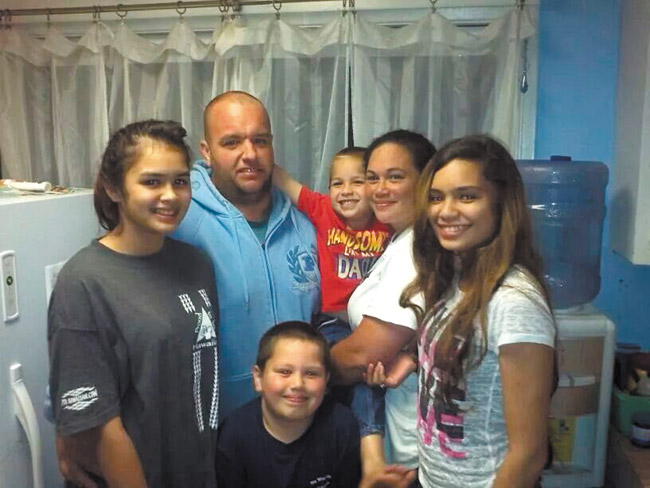Iselle, Julio: Flashbacks of Iniki, Iwa

Costa ohana (from left) Celia, Louis, Louis Jr., Melissa, Briana and Elijah (front) were thankful to have lights back on Aug. 10. Their food and water storage helped them weather the storm. PHOTO COURTESY WILLIAM BUCASASAS
Iselle and Julio were predicted to be the one-two punch couple that was to dance and whip its way through Hawaii.
We’re not talking about a couple on Dancing with the Stars; we’re talking about two hurricanes named Iselle and Julio, which everyone already knows whirled out of control toward Hawaii. Iselle made serious landfall Aug. 7, causing major havoc for East Hawaii residents on Hawaii island. Luckily, Julio, Iselle’s dancing partner, tangoed off into the sunset and blew north of us — and away from battering our homes and belongings.
When weather warnings, watches and forecasts of a possible category 4 hurricane beamed out of the airwaves days prior, most everyone in Hawaii braced themselves for the worst and flocked to the stores to get their hands on bottled water, Spam and other nonperishable goods. Water was a definite commodity, as store shelves were wiped clean statewide until new deliveries were made.
Veteran hurricane survivor Valerie Aquino Okimoto lived through Iniki and Iwa that ravaged her island of Kauai. She took all warnings seriously, even though she was not in the storm’s direct path. Severe flashbacks haunted her and took her back to 1991 and 1982.
“My neighbor’s house beam flew off and into the front window of our other neighbor across the street. I remember witnessing the windows of our humble home get pulled away from the frame of our house, and just when I thought for sure they would get sucked off and blown away, they would settle back into the walls again. The fleeting calm of Hurricane Iniki as its eye passed over us gave us a brief relief from the storm’s chaos, only to be followed by more rains and winds,” recalls Okimoto.
Fast forward to 2014: Iselle weakened, but she still left behind a major path of destruction, particularly in upper Puna, resulting in people being left in the dark as trees snapped like toothpicks and loose power lines made 360-degree turns several times over.
Islanders took to the motto, “If you are prepared, you shall not fear.” Glenwood residents Melissa and Louis Costa are prime examples. They already had stocked up buckets of water from their catchment system, so the heavy rains gave them ample supply to carry the family through to weather the storms. The Costas had to cook in the dark for three nights because of power outages caused by the category 2 hurricane.
“We used our new propane stove, and my four children had flashlights and oil lamps so they could do their homework. It was fun for them the first two nights playing board games and cards, but it got old when they got tired of scooping water from a bucket and our food in the refrigerator was getting warmer and needed to be circulated,” says Melissa Costa.
She adds, “We searched every store and nobody had ice, not even the companies that made ice.”
Costa’s food storage and quick thinking were her weapons for survival.
Iselle mesmerized North Kohala resident John Cornillez, who became a romantic overnight poet as a result of Iselle’s feisty and fierce charm. Cornillez recorded on his Facebook journal that he awoke around 12:30 a.m. Aug. 7 with the sound of the wind and rain howling like never before, as the brunt of the hurricane laid upon his home.
“The full moon cast an eerie glow outside. I could see trees bend madly in the fierce wind. Huge gusts ready to topple the trees — the sound was deafening,” describes Cornillez. When the winds died down, he says, “The heavens opened and the full moon appeared. It was the eye of the storm (in my opinion) passing overhead. Spectacular sight … clouds parted, the bright full moon lit the dark sky and more clouds circled all around the distance.”
In the Costas’ neighborhood of Glendale, Iselle wasn’t so kind.
“When we got out to assess the damage, rocks and debris blanketed our roads. A farmer five minutes from our home lost his greenhouse, and all that was left were twisted metal frames and a shredded fabric roof. Luckily, an angel among us cleared and cut the downed trees to allow residents to drive safely,” says Costa.
Angels such as Larry Schrader of Kopua Farm Lots, who cleared roads that were closed by the fallen trees.
What frightened Costa was the storm’s aftermath. Trees toppled on top of power lines sagging them almost to the point where you could touch the wires and be electrocuted had the power surged back up.
“As I drove my kids to the first day of school following the storm Aug. 13, people still had tarps on their roofs,” she says.
As I toured the brunt of the storm damage last week, it was tough to ignore the invasive albizia trees along Upper Puna Road. Though no one was seriously hurt by the toppled hardwoods during the hurricane, residents feared these towering trees with shallow roots might wreak major havoc and injure someone during hurricanes in the future. The albizia tree invasion on Hawaii island is certainly an ecological and public-safety concern throughout the state.
Anticipating natural disasters is one thing, but dealing with an invasive specious tree problem is one less challenge Hawaii islanders need to deal with right now.
We also are beginning to realize the damage that was done to our farmers and our agricultural industry was quite extensive, especially in Kau as well as Puna. Hawaii island always has been touted as the state’s agricultural breadbasket, so helping our producers of macadamia nuts, coffee, papaya and flowers has got to be a top priority.
mufi@mufihannemann.com





